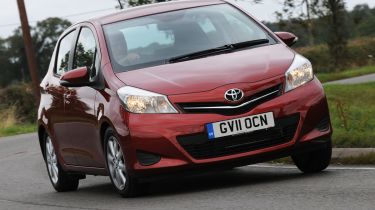Toyota Yaris 1.33 TR
Latest model promises more room and refinement, and has class leaders in its sights
Can the new Yaris reignite Toyota’s flagging fortunes in the supermini sector?
At first glance, the latest model won’t set pulses racing. While it’s more modern than before, its anonymous lines aren’t going to set it apart from the crowd. The front end reflects the latest family look, so the Yaris is similar to the Verso S supermini-MPV, which is hardly a glowing endorsement.
Video: watch CarBuyer's video review of the Toyota Yaris
[[{"type":"media","view_mode":"content_narrow","fid":"68698","attributes":{"alt":"","class":"media-image"}}]]
Along the flanks, you can see echoes of the outgoing model in the shape of the doors and high shoulder line, while the rear bumper and tailgate take their cue from the bigger Auris. The Yaris has grown in length by 100mm (with an extra 50mm between the wheels) and the roofline has dropped by 20mm for a sportier stance.
The longer wheelbase is good news for passengers, as the Yaris still has plenty of space inside. Rear headroom is unaffected by the lower roofline and the cabin has the feel of an MPV, thanks to its high seating position and low window line. Nasty blindspots caused by the raked A-pillars are an unwelcome addition, though.
Inside, your attention is quickly drawn to the low-rent quality of the trim. Some of the strangely textured plastics look and feel very cheap. The dashboard design is simple and attractive, but owners of the original Yaris – with its centrally placed digital speedo – will find the latest model conventional.
Used - available now

2024 Volkswagen
Golf
25,158 milesManualPetrol1.5L
Cash £16,800
2022 Mercedes
A-Class Saloon
17,937 milesManualPetrol1.3L
Cash £20,600
2021 Audi
A6 Avant
39,141 milesAutomaticPetrol2.0L
Cash £28,800
2022 Mercedes
GLA
28,365 milesAutomaticPetrol1.3L
Cash £21,500On the plus side, the instruments are easy to read and the switchgear is logically laid out. A large touchscreen monitor dominates the centre of the dash. It comes as standard on all but entry-level T2 models. The Toyota Touch system provides control of the stereo, Bluetooth and rear view camera. Plus, for a limited time, there’s a free upgrade to include a sat-nav system (dubbed Toyota Touch & Go). Mid-range TR models feature a leather steering wheel and gearlever, while all versions get seven airbags.
In the back, the tall roofline provides decent headroom, while a flat rear floor improves legroom in the centre seat. Despite this, and the longest wheelbase on test, the Yaris has only a fraction more legroom than the Ford and Mazda. And its 60/40 split-folding rear seats don’t slide or offer anything to set it apart from its rivals.
Under the bonnet, the 1.33-litre petrol engine is familiar from the outgoing car, and with Toyota’s established variable valve timing, it’s keen to rev and spirited in nature. With 99bhp the Yaris is the most powerful car in our quartet, too, and has the biggest torque output, at 125Nm. It’s also the only model with the added flexibility and shorter ratios of a six-speed box, so it was no surprise it was the strongest performer at the track.
It feels quicker to respond at any speed, and has the edge over its rivals for sheer pace. However, this is tempered by the engine, which is strained at higher revs, meaning extracting its performance isn’t a relaxing experience. And for all its potency, the Yaris falls short of refinement compared to the Fiesta and Swift. At motorway speeds, there’s a lot of wind noise around the A-pillars, while the ride is unsettled on all but the smoothest surfaces. On bumpy roads, the suspension fidgets constantly, and at speed, the ride becomes bouncy. Around town, the light controls make for easy driving, and this is where the Toyota is at its best.
European versions have been tuned to deliver sharper driving dynamics than their Japanese counterparts, but the Yaris is no match for its rivals in this test. The steering is positive, but provides little feedback or feel, while poor body control and an intrusive stability control system mean it doesn’t cope well with swift changes of direction. In corners, it can’t match the grip of its competitors here. All of this makes the Toyota far less engaging to drive. In short, it can’t match their agility or sense of fun.
On the upside, it put in an impressive performance when we measured its braking ability. However, in a class populated by some of the most talented cars around, this isn’t going to be enough to take top honours. The high price and average drive mean the Yaris faces a battle to avoid the wooden spoon.
Details
Chart position: 4
WHY: Latest Yaris is bigger and better equipped than before, and aims to build on its strengths. We test the predicted best-seller – the 1.33-litre TR petrol.







